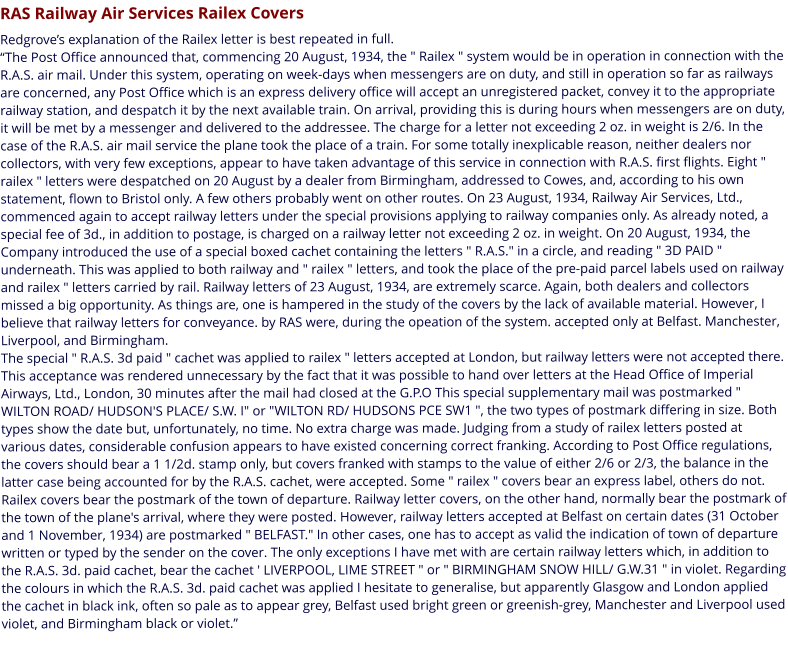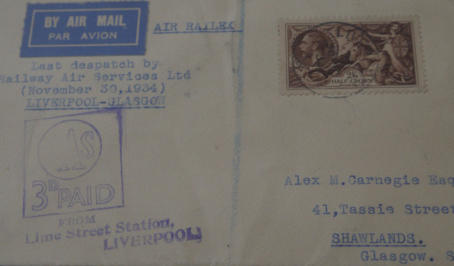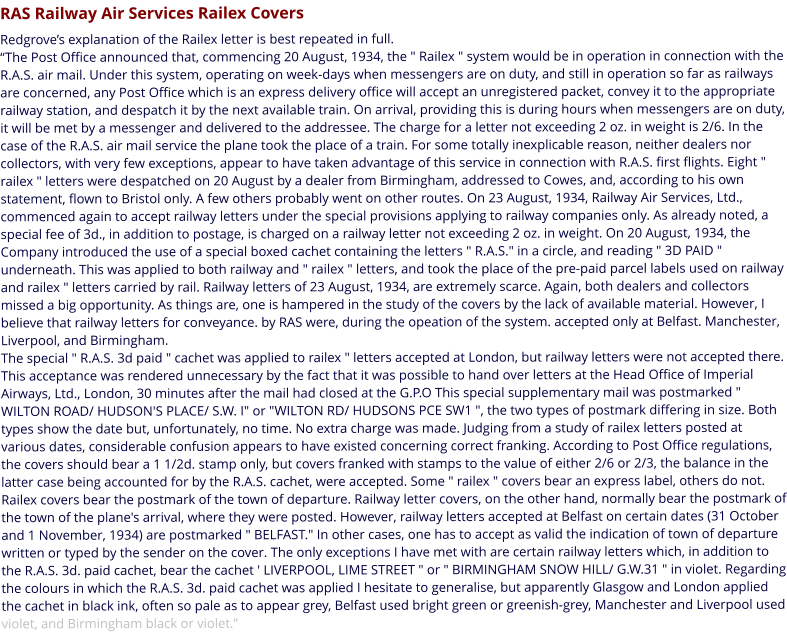
Railway Air Services - Railex
Copyright
© 2022 Robert Farquharson All Rights Reserved

As described above very few railex letters were sent on the first day, the main block being eight sent by a dealer from Birmingham to Cowes. That dealer
was Francis Field and two of the eight envelopes sent are shown below. The covers only got as far as Bristol when bad weather prevented any further
progress, and they were sent by surface to Freshwater Bay. Curiously the first example has the 3d paid applied in manuscript. It would be presumed that
the 3d stamp was not yet available, but the second example also sent from Birmingham does have a 3d cachet. The second example also has a backstamp
first the 21st which is curious as it would surely have a backstamp of the 20th if sent on by surface after it reached Bristol.
First Railex


Railex letter sent on first day of service 20th Aug 1934
Railex letter sent on first day of service 20th Aug 1934
There was some confusion about how the 2sh 6d rate for the Railex service should be paid. It consisted of 2 shillings 1 1/2d for railex, 1 1/2d for the stamp,
and 3d for the Railway letter. Post Office instructions made clear that only a 1 1/2d stamp was required for the service, yet nearly all examples show the
whole 2sh and 6d being applied as stamps. As can be seen in the examples below the 2sh 6d seahorse was a popular choice, even though this meant
overpaying. In the second example the correct fee of 2sh and 3d has been applied even though the stamps were not required
On the 30th November, the Post Office relinquished its mail contract which was taken over by Hillman Airways on the London to Glasgow route. There was
no mail contract for the other two routes for this period. This was the last official date for railex as it was discontinued when the new contract resumed in
1935.
When the new contract was resumed, the Railex service was no longer available. The two examples below show this did not stop Railex letters being sent.
The first example is a test letter presumably to see whether railex were still being accepted. In the second example, the 2sh 6d paid has been dismissed
by the clerk as ‘senders excess’, then presumably sent on a normal non railex service.


Test Railex letter sent from Wick to London 2nd Dec 1934
Railex letter 30th November 1935 appears rejected.

British Internal Airmails of the 1930’s


Last day of service Birmingham to Liverpool Railex
First day of service Liverpool to London Railex
Oct 31st 1934 last flight to Manchester
Dec 2nd 1935 first flight new contract to Liverpool


Last Railex London to Liverpool 30th Nov 1934
Last Railex Liverpool to Glasgow 30th Nov 1934

The confusion over Railex letters at the beginning of the
new contract is illustrated on the example on the left.
The letter is clearly marked to go by air and it has
received an Express sticker which shows for certain it
was accepted as a Railex. While most letters had more
postage this is correct. Railex letters according to
regulations should only have the internal postage of 1
1/2d. The rest was paid to the office accepting the
Railex.

Railway Air Services - Railex
Copyright
© 2020 Robert Farquharson All Rights Reserved

As described above very few railex letters were sent on the first day, the main block being eight sent by a dealer from Birmingham to Cowes. That dealer
was Francis Field and two of the eight envelopes sent are shown below. The covers only got as far as Bristol when bad weather prevented any further
progress, and they were sent by surface to Freshwater Bay. Curiously the first example has the 3d paid applied in manuscript. It would be presumed that
the 3d stamp was not yet available, but the second example also sent from Birmingham does have a 3d cachet. The second example also has a backstamp
first the 21st which is curious as it would surely have a backstamp of the 20th if sent on by surface after it reached Bristol.
First Railex


Railex letter sent on first day of service 20th Aug 1934
There was some confusion about how the 2sh 6d rate for the Railex service should be paid. It consisted of 2 shillings 1 1/2d for railex, 1 1/2d for the stamp,
and 3d for the Railway letter. Post Office instructions made clear that only a 1 1/2d stamp was required for the service, yet nearly all examples show the
whole 2sh and 6d being applied as stamps. As can be seen in the examples below the 2sh 6d seahorse was a popular choice, even though this meant
overpaying. In the second example the correct fee of 2sh and 3d has been applied even though the stamps were not required
On the 30th November, the Post Office relinquished its mail contract which was taken over by Hillman Airways on the London to Glasgow route. There was
no mail contract for the other two routes for this period. This was the last official date for railex as it was discontinued when the new contract resumed in
1935.
When the new contract was resumed, the Railex service was no longer available. The two examples below show this did not stop Railex letters being sent.
The first example is a test letter presumably to see whether railex were still being accepted. In the second example, the 2sh 6d paid has been dismissed
by the clerk as ‘senders excess’, then presumably sent on a normal non railex service.

Test Railex letter sent from Wick to London 2nd Dec 1934

British Internal Airmails of the 1930’s


Last day of service Birmingham to Liverpool Railex
Oct 31st 1934 last flight to Manchester

Last Railex London to Liverpool 30th Nov 1934


























































































